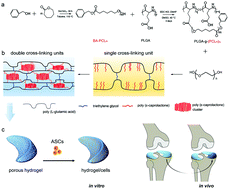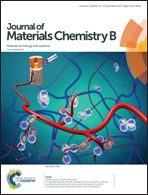In situ formation of hydrophobic clusters to enhance mechanical performance of biodegradable poly(l-glutamic acid)/poly(ε-caprolactone) hydrogel towards meniscus tissue engineering†
Abstract
The preparation of scaffolds represents a huge challenge for meniscus tissue engineering, as there are particular biomechanical and biodegradability requirements. Here, an amphiphilic polymer was prepared by grafting hydrophobic poly(ε-caprolactone) (PCL) with short chains onto hydrophilic biodegradable poly(L-glutamic acid) (PLGA). PLGA-g-PCL was then crosslinked with triethylene glycol (TEG) to form a chemically crosslinked network (CCN), followed by the in situ formation of stable hydrophobic PCL clusters inside the preformed CCN to increase the strength and elasticity of the hydrogel. The spindle-like PCL clusters in the hydrogel were observed to possess a mean size of 5–10 μm on the long axis and 3–4 μm on the minor axis, with no crystallization according to WAXS. Owing to the hydrophobic association of PCL, the swollen CCN was secondarily crosslinked and stiffened. Dynamic mechanical analysis (DMA) demonstrated excellent rebound resilience, and the maximum compressive strength of all the PLGA-g-PCL hydrogels was greater than 0.60 MPa with a maximum strain of about 70%, which represented significant increases in comparison with a PLGA hydrogel. Owing to the short chains of PCL, degradation of the PLGA-g-PCL hydrogel was accelerated within 3 months in vivo. A hydrogel carrying adipose-derived stem cells (ASCs) effectively regenerated meniscus-like tissue in vivo and preserved the corresponding articular cartilage from degeneration over a 16 week period.



 Please wait while we load your content...
Please wait while we load your content...